|
|
A
Close-up View of the Wildflower (Dianthus armeria) |
|
|
A
Close-up View of the Wildflower (Dianthus armeria) |
This
small, but brightly coloured wildflower was given its name due to the
fact that it was supposed to have grown in abundance during Tudor times
in the fields near Deptford UK, now an industrial section of
London. Although the population of Deptford Pink plants is
thought to be on the increase in Europe and North America, in the UK it
is in serious decline. In fact, the plant has an endangered
listing, and is therefore protected in many areas. I imagined
that “Pink” referred to the colour, however some sources say that it
relates to the serrated edge of each petal looking as though it was
trimmed by “pinking
shears”. The genus name Dianthus comes
from the Greek dios, meaning
“of Zeus” and anthos, meaning
“flower”, translating roughly to “flower
of the god(s)”. The species name armeria derives
from the Latin flos armeriae,
a type of flower.
The plants photographed for this article were growing in an open field
near a row of trees. The field was mowed infrequently, and the
plants would appear a couple of weeks after each cutting. This
limited their height to about 15 centimetres.
Deptford
Pink flowers grow in small clusters at the end of a thin stiff stem,
which can be from 15 to 25 centimetres high. Each approximately
one centimetre diameter flower has five petals with toothed edges, and
a sprinkling of small white spots. The light green leaves are
blade-shaped and often form V’s near the top of the plant.

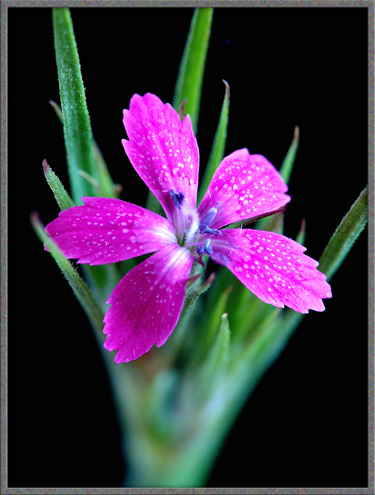
Note
in the two images that follow, the five lance-shaped (lanceolate) greenish-brown bracts, (modified leaves)
immediately beneath the petals. These bracts tend to cover the tubular
base of the flower and prevent the flower’s trumpet shape from being
apparent. In addition, most plants have three narrow green
leaf-like bracts at the base of each flower.


A
flower has five stamens, each consisting of a pale filament holding aloft a purple or
red anther, (male pollen
producing structure). There are also two stigmas, (female pollen accepting
structures), although they are out of focus in the images below, and
are not visible.
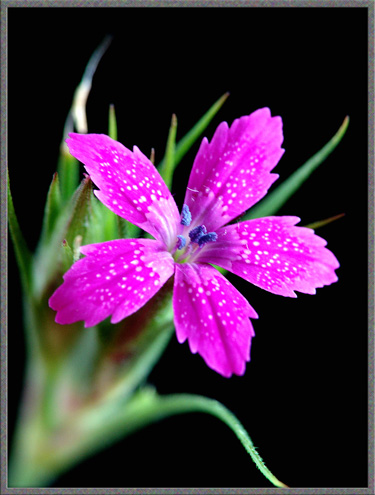
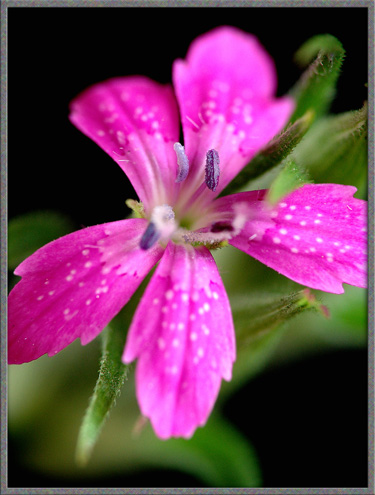
Under
the microscope a purple anther can be seen attached to its paler
rod-like filament. Several pollen grains are sticking to the
surface of the anther.
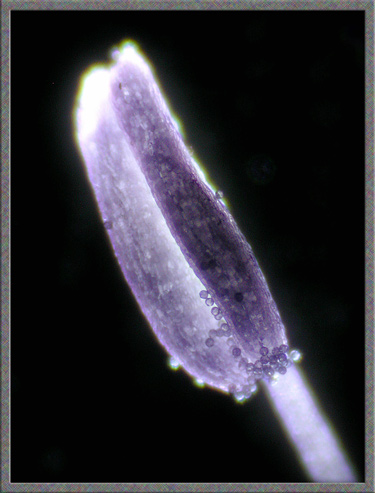
A
red anther is shown below. The higher magnification image on the
right shows many roughly spherical pollen grains.
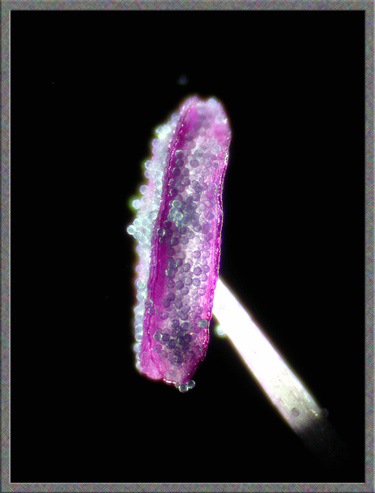

Notice
the single pollen grain at the centre of the image on the left
below. To the right is an enlargement of the grain revealing the
faceted shape, and the circular depression on each face.


Each Deptford Pink flower has two stigmas which project out a
considerable distance. This I suppose increases the chance of
fertilization by insect visitors. Each stigma is hairy, and tends
to be pink in colour at the tip. Notice also that the upper
bracts are striped in two shades of green, and are covered in fine
hairs.

The
following two images show the almost transparent glandular protrusions
that encircle the stigma. These hairs ensure that any pollen
grains brought by visiting insects are retained by the stigma when the
insect leaves.


Some
of the surface detail on a pollen grain adhering to the stigma is
visible in the image below.

The
following photomicrograph illustrates the adherence of pollen grains to
the glandular stigma hairs.

While
examining a flower petal under the microscope, I was surprised to find
that at the centre of each white spot on the petal’s surface, there is
a single tiny hair growing perpendicular to the surface. (What, I
wonder is the purpose of these hairs?)
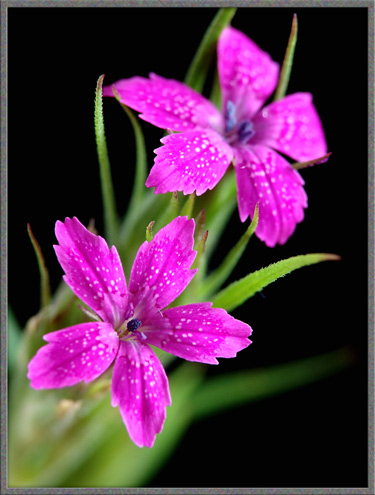
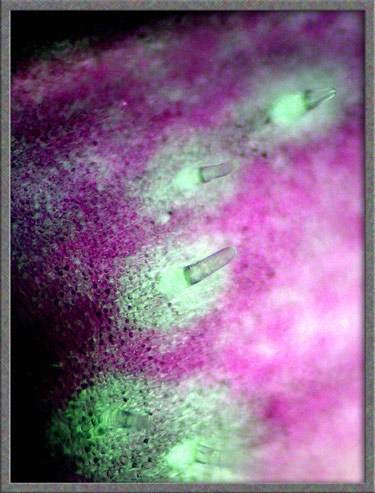
Before
blooming, a Deptford Pink plant has very grass-like leaves. This
makes identification very difficult until the plant blooms, revealing
the characteristic flowers. As the photograph shows, all surfaces
are covered with fine downy hairs. The higher magnification image
on the right shows a very immature bud, tinged with red.
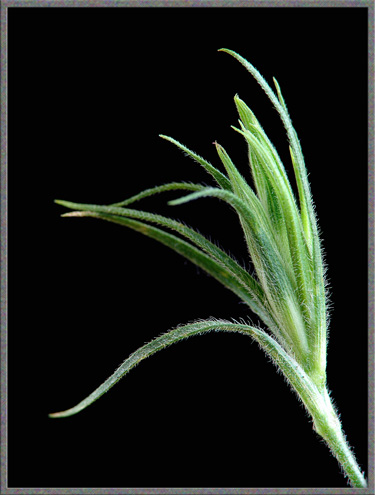
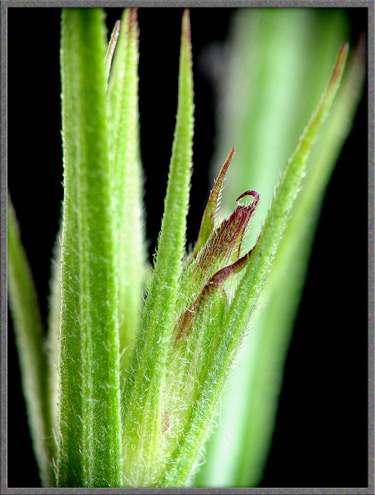
The
fine hairs at the edge of a leaf are visible in the photomicrograph
below. On the right is an image of a hair like structure which
was growing from the base of one of the bracts.


Although
this diminutive member of the pink family can’t compete with its more
spectacular close relative the carnation, it nevertheless deserves
close study when one is lucky enough to find a specimen.
Photographic
Equipment
The photographs in the article were taken with an eight megapixel Sony
CyberShot DSC-F 828 equipped with achromatic close-up lenses (Nikon 5T,
6T, Sony VCL-M3358, and shorter focal length achromat) used singly or
in combination. The lenses screw into the 58 mm filter threads of the
camera lens. (These produce a magnification of from 0.5X to 10X
for a 4x6 inch image.) Still higher magnifications were obtained
by using a macro coupler (which has two male threads) to attach a reversed 50 mm focal length f 1.4
Olympus SLR lens to the F 828. (The magnification here is about
14X for a 4x6 inch image.) The photomicrographs were taken with a Leitz
SM-Pol microscope (using a dark ground condenser), and the Coolpix
4500.
References
The following references have been
found to be valuable in the identification of wildflowers, and they are
also a good source of information about them.
A Flower Garden of Macroscopic Delights
A complete graphical index of all
of my flower articles can be found here.
The Colourful World of
Chemical Crystals
A complete graphical index of all
of my crystal articles can be found here.
All comments to the author Brian Johnston are welcomed.
Published in the
December 2008 edition of Micscape.
Please report any Web problems or
offer general comments to the Micscape
Editor.
Micscape is the on-line monthly magazine
of the Microscopy UK web
site at Microscopy-UK
© Onview.net Ltd, Microscopy-UK, and all contributors 1996 onwards. All rights reserved. Main site is at www.microscopy-uk.org.uk with full mirror at www.microscopy-uk.net .